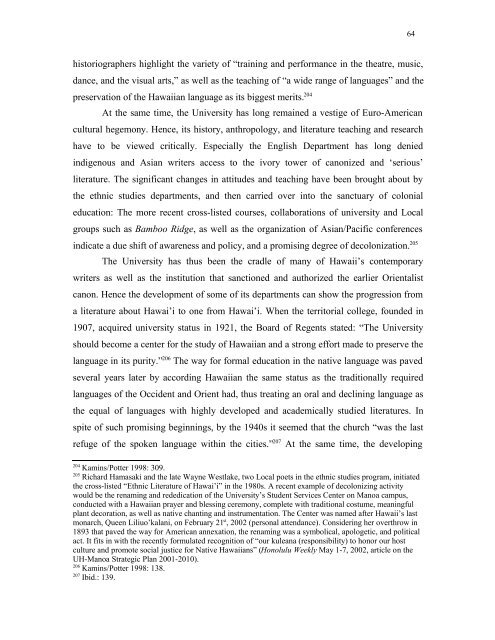A Paradise Lost - KOPS - Universität Konstanz
A Paradise Lost - KOPS - Universität Konstanz
A Paradise Lost - KOPS - Universität Konstanz
Create successful ePaper yourself
Turn your PDF publications into a flip-book with our unique Google optimized e-Paper software.
historiographers highlight the variety of “training and performance in the theatre, music,<br />
dance, and the visual arts,” as well as the teaching of “a wide range of languages” and the<br />
preservation of the Hawaiian language as its biggest merits. 204<br />
At the same time, the University has long remained a vestige of Euro-American<br />
cultural hegemony. Hence, its history, anthropology, and literature teaching and research<br />
have to be viewed critically. Especially the English Department has long denied<br />
indigenous and Asian writers access to the ivory tower of canonized and ‘serious’<br />
literature. The significant changes in attitudes and teaching have been brought about by<br />
the ethnic studies departments, and then carried over into the sanctuary of colonial<br />
education: The more recent cross-listed courses, collaborations of university and Local<br />
groups such as Bamboo Ridge, as well as the organization of Asian/Pacific conferences<br />
indicate a due shift of awareness and policy, and a promising degree of decolonization. 205<br />
The University has thus been the cradle of many of Hawaii’s contemporary<br />
writers as well as the institution that sanctioned and authorized the earlier Orientalist<br />
canon. Hence the development of some of its departments can show the progression from<br />
a literature about Hawai’i to one from Hawai’i. When the territorial college, founded in<br />
1907, acquired university status in 1921, the Board of Regents stated: “The University<br />
should become a center for the study of Hawaiian and a strong effort made to preserve the<br />
language in its purity.” 206 The way for formal education in the native language was paved<br />
several years later by according Hawaiian the same status as the traditionally required<br />
languages of the Occident and Orient had, thus treating an oral and declining language as<br />
the equal of languages with highly developed and academically studied literatures. In<br />
spite of such promising beginnings, by the 1940s it seemed that the church “was the last<br />
refuge of the spoken language within the cities.” 207 At the same time, the developing<br />
204 Kamins/Potter 1998: 309.<br />
205 Richard Hamasaki and the late Wayne Westlake, two Local poets in the ethnic studies program, initiated<br />
the cross-listed “Ethnic Literature of Hawai’i” in the 1980s. A recent example of decolonizing activity<br />
would be the renaming and rededication of the University’s Student Services Center on Manoa campus,<br />
conducted with a Hawaiian prayer and blessing ceremony, complete with traditional costume, meaningful<br />
plant decoration, as well as native chanting and instrumentation. The Center was named after Hawaii’s last<br />
monarch, Queen Liliuo’kalani, on February 21 st , 2002 (personal attendance). Considering her overthrow in<br />
1893 that paved the way for American annexation, the renaming was a symbolical, apologetic, and political<br />
act. It fits in with the recently formulated recognition of “our kuleana (responsibility) to honor our host<br />
culture and promote social justice for Native Hawaiians” (Honolulu Weekly May 1-7, 2002, article on the<br />
UH-Manoa Strategic Plan 2001-2010).<br />
206 Kamins/Potter 1998: 138.<br />
207 Ibid.: 139.<br />
64

















